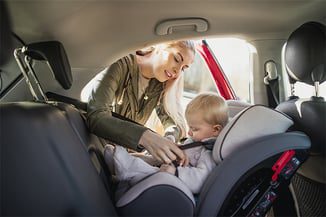After a baby is born, hospitals will not allow a newborn to leave the hospital without a proper car seat. Although the majority of new parents buy car seats long before the arrival of the baby, new parents may not know that both state and federal law requires certain types of car seats depending on the age and weight of the child.
For purposes of this article, the requirements of Wisconsin for car seats will be discussed. However, keep in mind that according to Wisconsin Statute Section 347.48(4)(am), car seats must also meet federal standards. These federal standards can be found at 49 C.F.R. § 571.213. In addition, it is also important to know the consequences of violating the laws on child restraint systems in Wisconsin.

What Happens If You Don’t Use A Car Seat?
Law enforcement officers may give citations to drivers who do not properly restrain children under eight years of age in restraints that fit the child’s age and weight. Wis. Stat. § 347.48(4)(am). This means that if a law enforcement officer stops a driver for another traffic violation and notices that a child’s car seat is too small or not the required type of restraint, the driver may also be issued an additional citation.
Moreover, in the case of a car accident, if a child is not properly restrained and suffers injuries, evidence of the driver’s failure to properly restrain the child may be admitted in civil actions. Although it may be admitted to show negligence, violating the statute, it does not however, automatically constitute negligence. Wis. Stat. § 347.48(4)(d).
What Are The Car Seat Requirements Under Wisconsin Law?
Wisconsin Statute Section 347.48(4)(as) provides the requirements for child safety restraints. The statute breaks down by the height and weight of the child. Here are the key provisions:
- If a child is less than one year old or weighs less than 20lbs, the child must be restrained in the back passenger seat in a rear-facing car seat. Wis. Stat. § 347.48(4)(as)(1).
- When the child outgrows the first type of seat and is at least 20lbs, but less than 40lbs and between the ages of one and four, the options include the rear seat with a rear facing car seat or a rear seat with a forward facing car seat. The child remains in the rear seat, but has the option of rear or forward facing car seat placement. Wis. Stat. § 347.48(4)(as)(2).
- When the child weighs between 40lbs and 80lbs, is between the ages of four and eight, and is not taller than 57 inches in height, the child should still be seated in the back seat and either in a forward-facing car seat or a booster seat. Wis. Stat. § 347.48(4)(as)(3).
- After a child reaches the height or weight restrictions in the previous statutory section, the child should still be restrained in a booster seat until the seat belt fits properly. See http://www.safercar.gov/parents/RightSeat.htm.
Although not required by law, it is recommended that children under twelve years old should remain in the back seat. You will usually see this warning on the visor in the front passenger seat of the vehicle and this is because children under the age of twelve are at an increased risk of injury if the airbag deploys.
Tips to Choose A Child Car Seat
When choosing a car seat for your child, it is important to remember there are numerous types of car seats such as infant-only seats, convertible seats, 3-in-1 seats, no-back booster seats, high-back booster seats, and others. Several types of seats fit into each requirement. For example, an infant only seat and a 3-in-1 seat both provide the requirements for a newborn child leaving the hospital. The height and weight restrictions for each car seat should be printed on the box pursuant to federal standards. Therefore, prior to purchasing a car seat, be sure to understand how long each seat can be used and the weight, height, or age limit before you will have to purchase a new seat.
Once a child is too big to use a car seat or booster seat, he or she is required to abide by the Wisconsin State law that requires all passengers in vehicles to wear a seatbelt. Wis. Stat. § 347.38(2m). In most cases, if a minor child is not wearing a seatbelt, the driver of the vehicle will be cited for breaking the law.
For further information on choosing the right car seat for your child, visit the NHTSA website. They have a printable brochure available for download to help you decide which car seat is the best for your child. The website can be found by following this link: http://www.safercar.gov/parents/RightSeat.htm
Injured As A Result of Car Accident?
Whether you were injured as a result of a car accident or your car seat did not perform as designed, also known as a product liability lawsuit, you may benefit from a free case evaluation. You’ll see the difference when you have the opportunity to talk directly with an expert personal injury lawyer.
Interested in learning more? Download a free ebook guide to help you understand the next steps in a personal injury claim.
At Murphy & Prachthauser we practice personal injury law the way it should be practiced – motivated and equipped to do our best for you. We take pride in being good lawyers who help people.
If you have a case you would like to speak to a lawyer about, please contact us to schedule a free case evaluation and get an experienced team of lawyers working on your behalf.